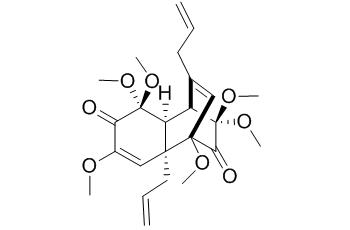Asatone
Asatone has antifeedant activity.
Inquire / Order:
manager@chemfaces.com
Technical Inquiries:
service@chemfaces.com
Tel:
+86-27-84237783
Fax:
+86-27-84254680
Address:
1 Building, No. 83, CheCheng Rd., Wuhan Economic and Technological Development Zone, Wuhan, Hubei 430056, PRC
Providing storage is as stated on the product vial and the vial is kept tightly sealed, the product can be stored for up to
24 months(2-8C).
Wherever possible, you should prepare and use solutions on the same day. However, if you need to make up stock solutions in advance, we recommend that you store the solution as aliquots in tightly sealed vials at -20C. Generally, these will be useable for up to two weeks. Before use, and prior to opening the vial we recommend that you allow your product to equilibrate to room temperature for at least 1 hour.
Need more advice on solubility, usage and handling? Please email to: service@chemfaces.com
The packaging of the product may have turned upside down during transportation, resulting in the natural compounds adhering to the neck or cap of the vial. take the vial out of its packaging and gently shake to let the compounds fall to the bottom of the vial. for liquid products, centrifuge at 200-500 RPM to gather the liquid at the bottom of the vial. try to avoid loss or contamination during handling.
FEMS Microbiol Lett.2017, 364(11)
Universite de Bordeaux2017, 2017BORD0867
J.Korean Society of Grassland&Forage Science2023, 43(3):138-147.
Molecules.2019, 24(20):3755
Int J Mol Sci.2024, 25(17):9730.
Research Square2020, doi: 10.21203.
Molecules2022, 27(11):3606.
Pharmaceutics2022, 14(2),376.
Biomed Chromatogr.2020, e5021.
Sci Rep.2021, 11(1):11936.
Related and Featured Products
J Chem Ecol. 1995 Oct;21(10):1541-8.
A neolignoid feeding deterrent againstLuehdorfia puziloi larvae (lepidoptera: Papilionidae) fromHeterotropa aspera, a host plant of sibling species,L. japonica.[Pubmed:
24233682 ]
METHODS AND RESULTS:
A feeding deterrent against larvae of a papilionid butterfly,Luehdorfia puziloi (Parnassiinae), a specialist on Asiasarum plants (Aristolochiaceae), was isolated from another aristolochiaceous plant,Heterotropa aspera. Antifeedant activity was exhibited by then-hexane-soluble fraction that proved to contain at least two active components.
CONCLUSIONS:
One of the deterrents was identified as a neolignan compound, Asatone. The concentration of Asatone in H. aspera was estimated at approximately 225 ppm, and larval feeding ofL. puziloi was significantly deterred at concentrations over 90 ppm. By contrast, Asatone was not detectable (< 1 ppm, if any) in its host plant,Asiasarum sieboldii.



